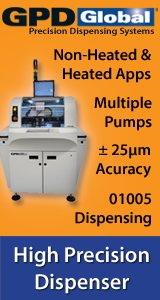Printed Circuit Board Assembly & PCB Design Forum
SMT electronics assembly manufacturing forum.
- SMTnet
- »
- Electronics Forum
- »
- Swatch Group Granted Lead Exemption?????
Swatch Group Granted Lead Exemption?????
Views: 9055
![]() I heard that Swatch was granted their exemption to use lead ...
- Apr 18, 2007
by
I heard that Swatch was granted their exemption to use lead ...
- Apr 18, 2007
by
![]()
![]() Chris, look here
...
- Apr 18, 2007
by
Patrick Bruneel
Chris, look here
...
- Apr 18, 2007
by
Patrick Bruneel
![]()
![]()
![]() Patrick,
I knew Swatch applied for an exemption but was i...
- Apr 18, 2007
by
Patrick,
I knew Swatch applied for an exemption but was i...
- Apr 18, 2007
by
![]()
![]() I wonder if you could push this to exempt any board with SnP...
- Apr 20, 2007
by
I wonder if you could push this to exempt any board with SnP...
- Apr 20, 2007
by
![]()
![]() James,
Smart thinking!!
That�s what Swatch and probably...
- Apr 20, 2007
by
Patrick Bruneel
James,
Smart thinking!!
That�s what Swatch and probably...
- Apr 20, 2007
by
Patrick Bruneel
![]()
![]()
![]() > I wonder if you could push this to exempt any
> bo...
- Apr 20, 2007
by
Stephen
> I wonder if you could push this to exempt any
> bo...
- Apr 20, 2007
by
Stephen
![]()
![]()
![]() Only if they pass functional testing -:)
...
- Apr 20, 2007
by
Only if they pass functional testing -:)
...
- Apr 20, 2007
by
![]()
![]() But the function would be to get a ROHS exemption.
...
- Apr 20, 2007
by
Stephen
But the function would be to get a ROHS exemption.
...
- Apr 20, 2007
by
Stephen
![]()
![]()
![]() Stephen,
This is brilliant!! Sorry my elevator is a littl...
- Apr 20, 2007
by
Stephen,
This is brilliant!! Sorry my elevator is a littl...
- Apr 20, 2007
by
![]()
![]() This does not make any sense at all. 0.65mm is 25 mil pitch...
- Apr 20, 2007
by
This does not make any sense at all. 0.65mm is 25 mil pitch...
- Apr 20, 2007
by
![]()
![]() I would hope that the committee is at least intelligent enou...
- Apr 23, 2007
by
Steve Thomas
I would hope that the committee is at least intelligent enou...
- Apr 23, 2007
by
Steve Thomas
![]()
![]()
![]() Am I missing something, or does this exemption only apply to...
- Apr 23, 2007
by
Steve Thomas
Am I missing something, or does this exemption only apply to...
- Apr 23, 2007
by
Steve Thomas
![]()
![]()
![]() Steve,
You read it the same way I read it. Some of my co...
- Apr 23, 2007
by
Steve,
You read it the same way I read it. Some of my co...
- Apr 23, 2007
by
![]()
![]() Chris,
WEEE is great but RoHS doesn�t make since, here�...
- Apr 23, 2007
by
Patrick Bruneel
Chris,
WEEE is great but RoHS doesn�t make since, here�...
- Apr 23, 2007
by
Patrick Bruneel
![]()
![]()
![]() It would make sence for Swatch I guess, they probably dont u...
- Apr 24, 2007
by
Loco
It would make sence for Swatch I guess, they probably dont u...
- Apr 24, 2007
by
Loco
![]()
![]()
![]() Patrick, firstly, I don't disagree with you on the efficacy ...
- Apr 24, 2007
by
Steve Thomas
Patrick, firstly, I don't disagree with you on the efficacy ...
- Apr 24, 2007
by
Steve Thomas
![]()
![]()
![]() Hi,
The verbiage states lead finish on components and not...
- Apr 24, 2007
by
Hi,
The verbiage states lead finish on components and not...
- Apr 24, 2007
by
![]()
![]() ...
- Apr 25, 2007
by
...
- Apr 25, 2007
by
![]()
![]()
![]() I'm reading that the same as you - which would mean everythi...
- Apr 25, 2007
by
Rob
I'm reading that the same as you - which would mean everythi...
- Apr 25, 2007
by
Rob
![]()
![]()
![]() I read the request months ago with great interest. However, ...
- Apr 25, 2007
by
Steve Thomas
I read the request months ago with great interest. However, ...
- Apr 25, 2007
by
Steve Thomas
![]()
![]()
![]() Steve,
See the link below. See the out take from the lin...
- Apr 25, 2007
by
Steve,
See the link below. See the out take from the lin...
- Apr 25, 2007
by
flipit
- SMTnet
- »
- Electronics Forum
- »
- Swatch Group Granted Lead Exemption?????








